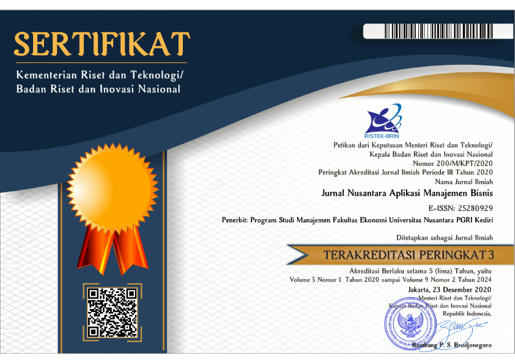Marketing Strategy Bagi Sociopreneurship: Extended Brand Melalui Penggunaan E-commerce Dalam Meningkatkan Brand Preference
DOI:
https://doi.org/10.29407/nusamba.v7i2.17819Keywords:
brand offering, Internet Shopping Experience, Word of Mouth, Brand Familiarity, Brand Evaluation, Brand PreferenceAbstract
Sociopreneurs by using a local values approach are expected to further encourage RT to take risks for better family life by involving the underprivileged and marginalized. Another Way Towards Independent and Prosperous (Jalin Matra) which is one of the focuses of the Government East Java as a form of support for Sociopreneur by the Governor of East Java in 2014 with a poverty reduction agenda. Therefore, it is important for Mrs RT to know about the use of online media to market products. So, this research must also start by knowing the effect of brand offering, internet shopping experience, word of mouth, brand familiarity, brand evaluation on brand preference so that appropriate advice can be given regarding the appropriate use of online media for the products offered. The number of samples used in this study was 100 respondents. This study uses software called SPSS version 22.0 in managing data and analyzing data. This study has six hypotheses and five hypotheses are accepted and one hypothesis is rejected.
Downloads
References
[2] Fakih, Mansour. Analisis Gender dan Transformasi Sosial. Yogyakarta, 2008: Pustaka Pelajar
[3] Sääksjärvi, M., dan S. Samiee, 2007, Nonprice Antecedents of Consumer Preference for Cyber and Extension Brands, Journal of Interactive Marketing, Vol. 21: 22–35.
[4] Shim, S., M.A. Eastlick, S.L. Lotz, P. Warrington, 2001, An Online Prepurchase Intentions Model: The Role of Intention to Search, Journal of Retailing, Vol. 77: 397–416.
[5] Kotler, P., K.L. Keller, S.H. Ang, S.M. Leong, dan C.T. Tan, 2009, Marketing Management An Asian Perspective, 5th Edition, Prentice Hall.
[6] Szymanski, D., dan R.T. Hise, 2000, E-Satisfaction: An Initial Examination, Journal of Retailing, Vol. 76: 309–322.
[7] Park, J., dan L. Stoel, 2005, Effect of Brand Familiarity, Experience and Information on Online Apparel Purchase, International Journal of Retail and Distribution Management, Vol. 33: 148–160.
[8] Wolfinbarger, M., dan M.C. Gilly, 2001, Shopping Online for Freedom, Control, and Fun, California Management Review, Vol. 43: 34–55.
[9] Constantinides, E., 2004, Influencing The Online Consumer’s Behavior: The Web Experience, Internet Research, Vol. 14: 111–126.
[10] Li, Y., and J. Huang, 2009, Applying Theory of Perceived Risk and Technology Acceptance Model in The Online Shopping Channel, World Academy of Science, Engineering and Technology, p. 919–925.
[11] Crosby, L. A., & Johnson, S. L. (2004). The Three Ms of Customer Loyalty. Marketing Management, 13(4), 12-13.
[12] Agrawal M., dan S. Suresh, 2009, E-Shopping Customer Experiences: Modelling and Research Design for Threshold Shoppers, 3rd IIMA Conference on Marketing Paradigms for Emerging Economies, p. 56-67.
[13] Bone, P. F. (1995). Word-of-mouth effects on short-term and long-term product judgments. Journal of business research, 32(3), 213-223.
[14] Hoye, G.V., F. Lievens, 2009, Tapping the Grapevine: A Closer Look at Word of Mouth as a Recruitment Source, Journal of Applied Psychology, Vol. 94, No. 2: 341-352.
[15] Bone, P. F. (1992). Determinants of word-of-mouth communications during product consumption. ACR North American Advances.
[16] Wirtz, J. dan Chew, P. (2002). The Effects of Incentives, Deal Proneness, Satisfaction and Tie Strength on Word of Mouth Behaviour. International Journal of Service Industry Management, 13 (2): 141 – 162.
[17] Brown, J.J. & Reingen, P.H.,1987. Social ties and word-of-mouth referral behavior. Journal of Consumer Research, Vol. 14 No. 3, pp. 350-62
[18] Mizerski, R. W. (1982). An attribution explanation of the disproportionate influence of unfavorable information. Journal of consumer research, 9(3), 301-310.
[19] Mourali, M., Laroche, M., & Pons, F. (2005). Antecedents of consumer relative preference for interpersonal information sources in pre‐purchase search. Journal of Consumer Behaviour: An International Research Review, 4(5), 307-318.
[20] Lim, B.C., C.M.Y. Chung, 2011, The Impact of Word-of-Mouth Communicaion on Attribute Evaluation, Journal of Business Research, Vol. 64: 18-23.
[21] Arslan, F.M., dan O.K. Altuna, 2010, The Effect of Brand Extensions on Product Brand Image, Journal of Product and Brand Management, Vol. 19: 170–180.
[22] Keller, K. L., 1993, Conceptualizing, Measuring, and Managing Customer-Based Brand Equity, Journal of Marketing, Vol. 57: 1–22.
[23] Baker, W., J.W. Hutchinson, D. Moore, P. Nedungadi, 1986, Brand Familiarity and Advertising: Effects on The Evoked Set and Brand Preference, Advances in Consumer Research, Vol. 13: 637–642.
[24] Alba, J. W., & Hutchinson, J. W. (1987). Dimensions of consumer expertise. Journal of consumer research, 13(4), 411-454.
[25] Aaker, D.A. and Keller, K.L. (1990), “Consumer evaluations of brand extensions”, Journal of Marketing, Vol. 54 No.1, pp. 27-41.
[26] Bettman, J.R., dan M. Sujan, 1987, Effects of Framing on Evaluation of Comparable and Noncomparable Alternatives by Expert and Novice Consumers, Journal of Consumer Research, Vol. 14: 141–154.
[27] Nedungadi, P.,1990, Recall and Consumer Consideration Sets: Influencing Choice without Altering Brand Evaluations, Journal of Consumer Research, Vol. 17: 263–276.
[28] Jarvis, W. B. G., & Petty, R. (1996). The need to evaluate. Journal of Personality and Social Psychology, 70(1), 172-194.
[29] Vieira, V.A., 2009, Is the Need to Evaluate a Real Consumer’s Need?, Brazilian Administration Review, Vol. 6: 153–172.
[30] Zhou, L., Kim, C., & Laroche, M. (1996). Decision processes of the attraction effect: a theoretical analysis and some preliminary evidence. ACR North American Advances.
[31] Hellier, P. K., Geursen, G. M., Carr, R. A., Richard, J. A. (2003) Customer repurchase intention: a general structural equation model. European Journal of Marketing, 37(11/12), 1762-1800.
[32] Chang, H.H., C. Hsu, S.H. Chung, 2008 The Antecedents and Consequences of Brand Equity in Services Markets, Asia Pacific Management Review, Vol.13: 601-624.
[33] Blackwell, R. D., P. W. Miniard, et al. (2001). Consumer Behavior 9th ed. Fort Worth, Harcourt.
[34] Mulyanegara, R., dan Y. Tsarenko, 2005, A Conceptual Model Of Consumer Personality-Brand Preferences Relationship, Anzmac Conference: Branding, Monash University.
[35] Chomvilailuk, R., K. Butcher, 2010, Enhancing Brand Preference through Corporate Social Responsibility Initiatives in the Thai Banking Sector, Asia Pacific Hournal of Marketing and Logistics, Vol. 22: 397–418.
[36] Syamrilaode. (2011). Kelebihan dan Kelemahan Metode Kuantitatif. Diunduh pada 11 Februari 2019 dari World Wide Web: http://id.shvoong.com/writingandspeaking/presenting/2131807-kelebihan-dan-kelemahan-metodekuantitatif/
[37] Miles, M.B & Huberman A.M. 1984, Analisis Data Kualitatif. Terjemahan oleh Tjetjep Rohendi Rohidi. 1992. Jakarta: Penerbit Universitas Indonesia.
[38] Amelia, A. (2014). Consumer's brand preference over cyber brand and extension brand. International Journal of Trade and Global Markets, 7(3), 175-189.
Downloads
Published
Issue
Section
License
Authors who publish with this journal agree to the following terms:
- Copyright on any article is retained by the author(s).
- The author grants the journal, the right of first publication with the work simultaneously licensed under a Creative Commons Attribution License that allows others to share the work with an acknowledgment of the work’s authorship and initial publication in this journal.
- Authors are able to enter into separate, additional contractual arrangements for the non-exclusive distribution of the journal’s published version of the work (e.g., post it to an institutional repository or publish it in a book), with an acknowledgment of its initial publication in this journal.
- Authors are permitted and encouraged to post their work online (e.g., in institutional repositories or on their website) prior to and during the submission process, as it can lead to productive exchanges, as well as earlier and greater citation of published work.
- The article and any associated published material is distributed under the Creative Commons Attribution-ShareAlike 4.0 International License












